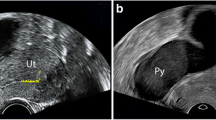Abstract
Although Atopobium vaginae has been reported as a causative organisms in patients with bacterial vaginosis and/or tubo-ovarian abscess, clinical significance of Atopobium species has not been defined to date. Here we report the case of uterine endometritis caused by A. vaginae.

Similar content being viewed by others
References
Collins MD, Wallbanks S. Comparative sequence analysis of the 16S rRNA genes of Lactobacillus minutus, Lactobacillus rimae and Streptococcus parvulus: proposal for the creation of a new genus Atopobium. FEMS Microbiol Lett. 1992;74:235–40.
Hauduroy P, Ehringer G, Urbain A, Guillot G, Magrou J. Dictionnaire des Bacteries pathogenes. Paris: Masson, 1937.
Olsen I, Johnson JL, Moore LVH, Moore WEC. Lactobacillus uli sp nov. and Lactobacillus rimae sp. nov. from the human gingival crevice and emended descriptions of Lactobacillus minutes and Streptococcus parvulus. Int J Syst Bacteriol. 1991;41:261–6.
Weinberg M, Nativalle R, Prevot AR. Les Microbes Anaerobies. Paris: Masson; 1937.
Stackebrandt E, Ludwig W. The importance of using outgroup reference organisms in phylogenetic studies: the Atopobium case. Syst Appl Microbiol. 1994;17:39–43.
Haas F, König H. Coriobacterium glomerans gen nov., sp. nov, from the intestinal tract of the soldier bug. Int J Syst Bacteriol. 1988;38:382–6.
Hillier SL, Homes KK. Bacterial vaginosis. In: Homes KK, Sparling PF, Mardh PA, Lemon SM, Stamm WE, Piot P, Wasserheit J, editors. Sexually transmitted diseases. New York: McGraw-Hill; 1999. p. 563–86.
Hecht DW. Evolution of anaerobe susceptibility testing in the United States. Clin Infect Dis. 2002;35(Suppl 1):S28–35.
Rodriguez Jovita M, Collins MD, Sjöden B, Falsen E. Characterization of a novel Atopobium isolate from the human vagina: description of Atopobium vaginae sp. nov. Int J Syst Bacteriol. 1999;49:1573–6.
Geißdörfer W, Böhmer C, Pelz K, Schoerner C, Frobenius W, Bogden C. Tuboovarian abscess caused by Atopobium vaginae following transvaginal oocyte recovery. J Clin Microbiol. 2003;41:2788–90.
Relman DA. New technologies, human–microbe interactions, and the search for previously unrecognized pathogens. J Infect Dis. 2002;186(Suppl 2):S254–8.
Fredricks DN, Fiedler TL, Marrazzo JM. Molecular identification of bacteria associated with bacterial vaginosis. N Engl J Med. 2005;353:1899–911.
Verhelst R, Verstraelen H, Claeys G, Verschraegen G, Delanghe J, Van Simaey L, et al. Cloning of 16S rRNA genes amplified from normal and disturbed vaginal microflora suggests a strong association between Atopobium vaginae, Gardnerella vaginalis and bacterial vaginosis. BMC Microbiol. 2004;4:16.
Verstraelen H, Verhelst R, Claeys G, Temmerman M, Vaneechoutte M. Culture-independent analysis of vaginal microflora: the unrecognized association of Atopobium vaginae with bacterial vaginosis. Am J Obstet Gynecol. 2004;191:1130–2.
Ferris MJ, Masztal A, Aldridge KE, Fortenberry JD, Fidel PL Jr, Martin DH. Association of Atopobium vaginae, a recently described metronidazole resistant anaerobe, with bacterial vaginosis. BMC Infect Dis. 2004;4:5.
Burton JP, Chilcott CN, Al-Qumber M, Brooks HJ, Wilson D, Tagg JR, et al. A preliminary survey of Atopobium vaginae in women attending the Dunedin gynaecology out-patients clinic: Is the contribution of the hard-to-culture microbiota overlooked in gynaecological disorders? Aust N Z J Obstet Gynaecol. 2005;45:450–2.
Ferris MJ, Masztal A, Martin DH. Use of species-directed 16S rRNA gene PCR primers for detection of Atopobium vaginae in patients with bacterial vaginosis. J Clin Microbiol. 2004;42:5892–4.
Swidsinski A, Mendling W, Loening-Baucke V, Ladhoff A, Swidsinski S, Hale LP, et al. Adherent biofilms in bacterial vaginosis. Obstet Gynecol. 2005;106:1013–23.
Theron MM, Janse Van Rensburg MN, Chalkley LJ. Nitroimidazole resistance genes (nimB) in anaerobic Gram-positive cocci (previously Peptostreptococcus spp.). J Antimicrob Chemother. 2004;54:240–2.
Author information
Authors and Affiliations
Corresponding author
About this article
Cite this article
Yamagishi, Y., Mikamo, H., Tanaka, K. et al. A case of uterine endometritis caused by Atopobium vaginae . J Infect Chemother 17, 119–121 (2011). https://doi.org/10.1007/s10156-010-0100-6
Received:
Accepted:
Published:
Issue Date:
DOI: https://doi.org/10.1007/s10156-010-0100-6




